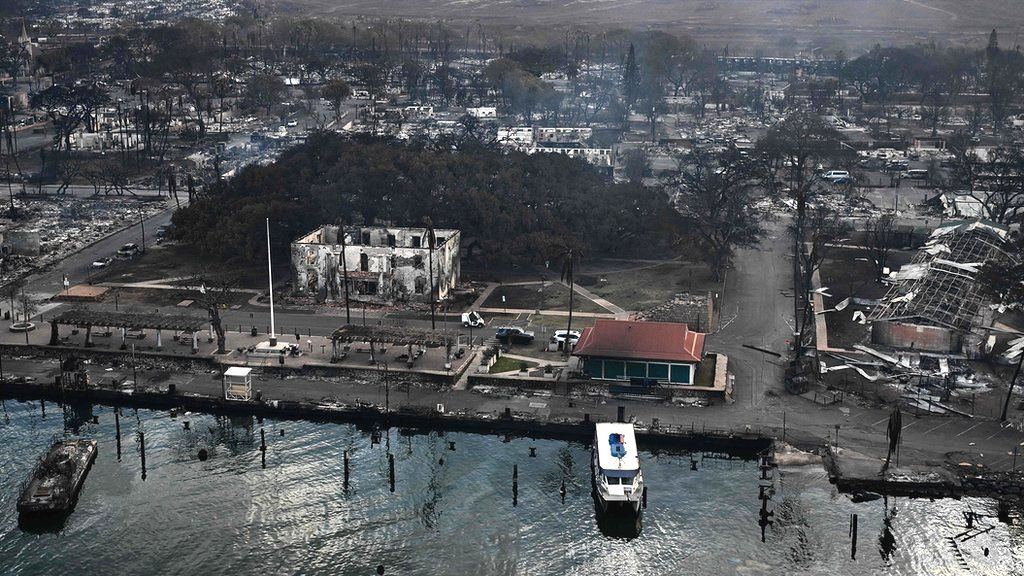Hawaii fire: Maps and before and after images reveal Maui devastation
- Published

Hawaiian officials are braced for a significant rise in the death toll from the fast-spreading wildfires, which caused devastation on the island of Maui and destroyed most of the historic town of Lahaina.
Hawaii Governor Josh Green said the fires were the "largest natural disaster in Hawaii state history" and that 80% of the beach-front town had "gone" - satellite images gave an immediate sense of the scale of the damage.
Your device may not support this visualisation
Hundreds of people remain missing almost a week after the disaster, and search teams have only covered a tiny percentage of the area affected.
The fires are now reported to be under control, but efforts to fully extinguish them continue on some parts of the island.
Maui fire map shows spread
Hundreds of people who fled their homes in Lahaina have been taking cover in an emergency shelter. About 2,700 homes are reported to have been destroyed.
Incredibly strong winds from Hurricane Dora, which passed south of Hawaii on Tuesday 8 August fanned the flames and prevented aircraft from flying over the town during the fire - but once they had passed, pilots were shocked by what they saw.
"It's horrifying. I've flown here 52 years and I've never seen anything come close to that," helicopter pilot Richard Olsten told the Associated Press news agency. "We had tears in our eyes."
The flames destroyed most of the buildings in front of the port, including the old courthouse.
Anger has grown among the community with many people telling the BBC they were not forewarned about the fires. It is currently unclear if early warning systems were used, or if they malfunctioned.
The town's lighthouse has survived but most of the surrounding buildings were destroyed, including the oldest hotel in Hawaii - the 122-year-old Pioneer Inn.
The centre of Lahaina dated back to the 1700s and was on the US National Register of Historic Places - it was once Hawaii's capital.
Buildings destroyed in Lahaina
The town was home to about 12,000 people - the initial assessments say about 86% of the damaged buildings were residential.
Alice Lee, chair of the Maui County Council, told the BBC World Service's Newsday programme how the fire razed the "beautiful" Front Street, the town's main strip.
"The fire traversed almost the entire street, so all the shops and little restaurants that people visited on their trips to Maui, most of them are burnt down to the ground," Lee said, adding: "So many businesses will have to struggle to recover," she said.
Former US President Barack Obama - who was born in Hawaii - is among those who has expressed his sorrow at the impact of the blaze. He posted on the X social network (formerly known as Twitter): "It's tough to see some of the images coming out of Hawaii — a place that's so special to so many of us."
"Michelle and I are thinking of everyone who has lost a loved one, or whose life has been turned upside down."
Lahaina banyan tree burnt
The fires also destroyed many natural features on the island - there are fears for Lahaina's banyan tree, the oldest in Hawaii, and one of the oldest in the US.
The 60ft-tall (18m) fig tree was planted in 1873, on the place where Hawaiian King Kamehameha's first palace stood, but it was burnt after fires ravaged the area on Wednesday.
According to the town's website, if its roots remain healthy it will likely grow back. But at this stage, they say the tree "looks burned".
Fires, drought and a hurricane
Most of the damage was done on Tuesday as the flames engulfed the town.
The blaze ripped through the town so quickly that some people jumped into the harbour to escape the flames and smoke.
The flames were fanned by gusts of wind of up to 65mph (100km/h) that hit the islands last week as Hurricane Dora passed about 700 miles (1,100km) south of Hawaii.
Drought or abnormally dry conditions across large parts of Hawaii - including the entire island of Maui - also played a role.
About 14% of the state is suffering from severe or moderate drought, according to the US Drought Monitor, while 80% of Hawaii is classed as abnormally dry.
Wildfires were once uncommon in Hawaii, ignited largely through volcanic eruptions or lightning strikes. But in recent decades, human activity has made them more common and extreme.
Climate change is increasing the risk of wildfire globally as it drives up temperatures and makes heatwaves longer and more intense.
"We have never experienced a wildfire that affected a city like this before," Governor Josh Green said, adding that the challenges of climate change were putting unprecedented strain on Hawaii.
By Chris Clayton, Dominic Bailey, Kady Wardell, Mike Hills, Tural Ahmedzade, Paul Sargeant, Gerry Fletcher, Filipa Silverio and Kate Gaynor.
How are you affected by the wildfires? If it is safe to do so please get in touch by emailing haveyoursay@bbc.co.uk.
Please include a contact number if you are willing to speak to a BBC journalist. You can also get in touch in the following ways:
- WhatsApp: +44 7756 165803
- Tweet: @BBC_HaveYourSay
- Upload pictures or video
- Please read our terms & conditions and privacy policy
If you are reading this page and can't see the form you will need to visit the mobile version of the BBC website to submit your question or comment or you can email us at HaveYourSay@bbc.co.uk. Please include your name, age and location with any submission.
- Published10 August 2023
- Published11 August 2023
- Published10 August 2023